Tomato Fruit Disorders
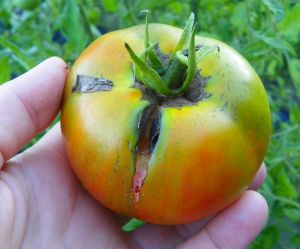
Tomatoes are the most popular vegetable that people grow in their gardens, and also one of the most requested at the farmer’s market. While tomatoes are typically pretty easy to care for, they are not without their leaf and fruit issues. I’ve covered leaf spot issues in the past, so this time we will focus on the fruit. When we think of tomato issues, the most common one that comes to mind is Blossom End Rot, but that disorder is not the only one that impacts the fruit. There are three disease issues that can impact tomato fruit, and several different disorders that can decrease the quality, shelf life, and even how edible the produce is. Let’s take a look at the most common ones and how to prevent them.
Anthracnose- This fungal disease is a frequent problem in the latter part of the growing season,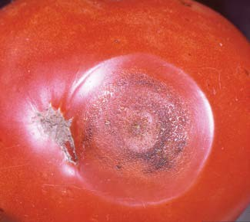 specifically on ripening tomato fruit. The symptoms of this disease first appear as small circular, slightly sunken lesions on the surface of ripening fruit. The spots quickly enlarge, becoming bruise-like depressions that develop a water-soaked appearance beneath the surface of the skin. Soon after, black concentric rings consisting of numerous small fruiting structures form in the center of the lesions. The fungus can survive in infected plant debris and in the soil. During rainy weather, fungal spores are splashed onto the fruit. Most infection takes place on ripe or overripe fruit. Green fruit can also be infected, although symptoms do not develop until the tomatoes begin to mature. Disease development is favored by frequent rainfall and temperatures around 80 degrees Fahrenheit. If you have had issues with anthracnose in the past, you can apply preventative sprays. Once the fruits are infected, they can’t be saved. Spray options include the active ingredients Bacillus subtilis, chlorothalonil, copper fungicides, or maneb. Be sure to read the label to check the post-harvest interval (how long after you spray before you can harvest the fruit) and make sure it is labeled for anthracnose and the vegetable you are spraying.
specifically on ripening tomato fruit. The symptoms of this disease first appear as small circular, slightly sunken lesions on the surface of ripening fruit. The spots quickly enlarge, becoming bruise-like depressions that develop a water-soaked appearance beneath the surface of the skin. Soon after, black concentric rings consisting of numerous small fruiting structures form in the center of the lesions. The fungus can survive in infected plant debris and in the soil. During rainy weather, fungal spores are splashed onto the fruit. Most infection takes place on ripe or overripe fruit. Green fruit can also be infected, although symptoms do not develop until the tomatoes begin to mature. Disease development is favored by frequent rainfall and temperatures around 80 degrees Fahrenheit. If you have had issues with anthracnose in the past, you can apply preventative sprays. Once the fruits are infected, they can’t be saved. Spray options include the active ingredients Bacillus subtilis, chlorothalonil, copper fungicides, or maneb. Be sure to read the label to check the post-harvest interval (how long after you spray before you can harvest the fruit) and make sure it is labeled for anthracnose and the vegetable you are spraying.
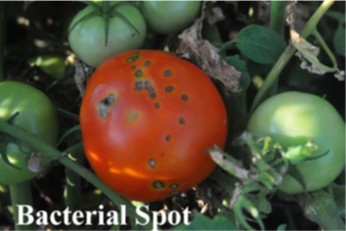 Bacterial Speck and Spot- In average Kansas summers, bacterial speck and bacterial spot of tomato are not common, but they can cause serious damage during wet growing seasons. On tomatoes, both diseases result in spot formation on the leaves and fruit. Heavy infection can cause defoliation, but the main effect of these diseases is the reduction of fruit quality. Leaf symptoms of bacterial speck and bacterial spot are similar. Both diseases cause small (⅛ to ¼ inch) black lesions on leaves. These spots are usually surrounded by a yellow halo. The lesions of bacterial spot tend to have a greasy appearance; those of bacterial speck do not. The two diseases are more easily distinguished by symptoms on the fruit. Bacterial spot results in small, black, slightly raised, water-soaked spots. These spots may enlarge to ¼ inch in diameter and become very rough and cracked. Bacterial speck lesions are also slightly raised, but typically are much smaller (1/16 inch) than those of bacterial spot. Bacterial speck lesions do not crack or become scaly, as in bacterial spot. These diseases can be prevented or reduced in severity by removal of plant debris in the fall, cultivation of weeds, rotation, and the use of clean (non-infested) seed and transplants. Start with the cultural practices described above. There are several copper-based compounds available for homeowners, but chemical control of bacterial diseases is inconsistent. Bacteria have extremely fast reproductive times, and it is difficult to manage an epidemic once it is underway. If you use a chemical, read and follow all label instructions.
Bacterial Speck and Spot- In average Kansas summers, bacterial speck and bacterial spot of tomato are not common, but they can cause serious damage during wet growing seasons. On tomatoes, both diseases result in spot formation on the leaves and fruit. Heavy infection can cause defoliation, but the main effect of these diseases is the reduction of fruit quality. Leaf symptoms of bacterial speck and bacterial spot are similar. Both diseases cause small (⅛ to ¼ inch) black lesions on leaves. These spots are usually surrounded by a yellow halo. The lesions of bacterial spot tend to have a greasy appearance; those of bacterial speck do not. The two diseases are more easily distinguished by symptoms on the fruit. Bacterial spot results in small, black, slightly raised, water-soaked spots. These spots may enlarge to ¼ inch in diameter and become very rough and cracked. Bacterial speck lesions are also slightly raised, but typically are much smaller (1/16 inch) than those of bacterial spot. Bacterial speck lesions do not crack or become scaly, as in bacterial spot. These diseases can be prevented or reduced in severity by removal of plant debris in the fall, cultivation of weeds, rotation, and the use of clean (non-infested) seed and transplants. Start with the cultural practices described above. There are several copper-based compounds available for homeowners, but chemical control of bacterial diseases is inconsistent. Bacteria have extremely fast reproductive times, and it is difficult to manage an epidemic once it is underway. If you use a chemical, read and follow all label instructions.
Tomato Cracking- Tomatoes typically crack because of fluctuations in the soil moisture. It’s common to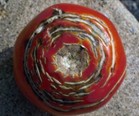 see cracks appear right after a heavy rain completely saturates the soil, as the tomatoes grow faster than the skin can stretch. Tomatoes can crack in two ways. Vertical splits, such as the photo at the beginning of this article, along the sides of the fruit, are known as radial cracking and are the most serious. This pattern of splitting commonly occurs during hot, humid weather. Cracking that occurs in a circular pattern, similar to the photo on the right, at the top of tomato fruits, ringing the stem end, is known as concentric cracking. With both radial and concentric cracking, your best option is to harvest fruits immediately, before they begin to rot. Your best bet is to keep the soil moisture as consistent as possible.
see cracks appear right after a heavy rain completely saturates the soil, as the tomatoes grow faster than the skin can stretch. Tomatoes can crack in two ways. Vertical splits, such as the photo at the beginning of this article, along the sides of the fruit, are known as radial cracking and are the most serious. This pattern of splitting commonly occurs during hot, humid weather. Cracking that occurs in a circular pattern, similar to the photo on the right, at the top of tomato fruits, ringing the stem end, is known as concentric cracking. With both radial and concentric cracking, your best option is to harvest fruits immediately, before they begin to rot. Your best bet is to keep the soil moisture as consistent as possible.
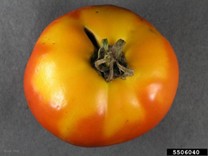 Yellow Shoulders- Yellow shoulders refer to when the top area on tomato fruit (“shoulder”) never ripens, staying hard and yellow or green even as the rest of the fruit is red. Tomatoes can also have issues ripening on the inside, with the inside flesh being white and hard. No matter how long these tomatoes are left on the vine, the shoulders and interiors do not ripen. Yellow shoulder is often seen in heirloom tomato cultivars, where the trait has not been improved through plant breeding. Conditions leading to yellow shoulders are a complex blend of environmental conditions and plant physiology, but it is very common during periods of high temperatures. The shoulders of the tomato, or the top edges of the fruit, are often exposed to the most heat and sun, so they are most prone to the problem. Maintain good soil moisture and fertility. Or harvest fruits at the pink stage and allow them to finish ripening indoors, away from outside stresses. This often helps the tomato ripen more evenly. Choose cultivars in the future with less susceptibility to yellow shoulders.
Yellow Shoulders- Yellow shoulders refer to when the top area on tomato fruit (“shoulder”) never ripens, staying hard and yellow or green even as the rest of the fruit is red. Tomatoes can also have issues ripening on the inside, with the inside flesh being white and hard. No matter how long these tomatoes are left on the vine, the shoulders and interiors do not ripen. Yellow shoulder is often seen in heirloom tomato cultivars, where the trait has not been improved through plant breeding. Conditions leading to yellow shoulders are a complex blend of environmental conditions and plant physiology, but it is very common during periods of high temperatures. The shoulders of the tomato, or the top edges of the fruit, are often exposed to the most heat and sun, so they are most prone to the problem. Maintain good soil moisture and fertility. Or harvest fruits at the pink stage and allow them to finish ripening indoors, away from outside stresses. This often helps the tomato ripen more evenly. Choose cultivars in the future with less susceptibility to yellow shoulders.
Catfacing- This issue can be a perennial problem for many home gardeners. Catfacing is an abiotic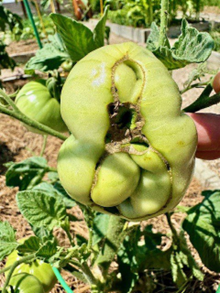 disorder of tomatoes that affects developing fruit. It is a deformity of the tomato fruit when the flower bud develops abnormally before blossoming. It results in the blossom end (bottom) of the fruit becoming cracked, misshapen, or having enlarged scars. The deformity’s resemblance to a cat’s puckered cheeks gives the disorder its unusual name. Large-fruit tomato varieties, like many of the heirloom types, are most often affected by catfacing. It should be noted that the deformity does not detract from the taste of the tomato. There are several causes of catfacing, including high levels of soil nitrogen, excessive pruning, cool temperatures when plants are planted, extreme fluctuations in day and nighttime temperatures, periods of drought followed by heavy rains, irrigation during ripening, and finally, exposure to herbicides. This disorder doesn’t impact the taste of the tomato; it simply makes it unattractive. To prevent this disorder, choose varieties that are less likely to have it, maintain a consistent soil temperature, avoid heavy early fertilization, and wait till after cool weather has passed before planting tomato plants outdoors.
disorder of tomatoes that affects developing fruit. It is a deformity of the tomato fruit when the flower bud develops abnormally before blossoming. It results in the blossom end (bottom) of the fruit becoming cracked, misshapen, or having enlarged scars. The deformity’s resemblance to a cat’s puckered cheeks gives the disorder its unusual name. Large-fruit tomato varieties, like many of the heirloom types, are most often affected by catfacing. It should be noted that the deformity does not detract from the taste of the tomato. There are several causes of catfacing, including high levels of soil nitrogen, excessive pruning, cool temperatures when plants are planted, extreme fluctuations in day and nighttime temperatures, periods of drought followed by heavy rains, irrigation during ripening, and finally, exposure to herbicides. This disorder doesn’t impact the taste of the tomato; it simply makes it unattractive. To prevent this disorder, choose varieties that are less likely to have it, maintain a consistent soil temperature, avoid heavy early fertilization, and wait till after cool weather has passed before planting tomato plants outdoors.
Many of these diseases can be prevented with proper sanitation of the garden after the growing season. While you may not be able to prevent all of the disorders that were discussed, you can reduce the chances of getting them through variety selection, consistent soil moisture (when the weather allows for it), and picking fruit when they first start to turn colors, but before they get too ripe.

Have questions? Contact our office where our Horticulture Extension Agent will assist you with questions.
Phone: (316) 321-9660
Email: callae@ksu.edu